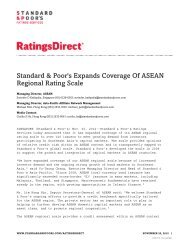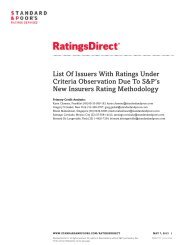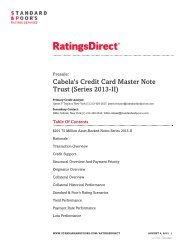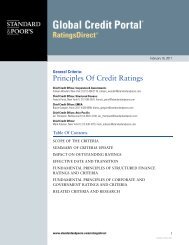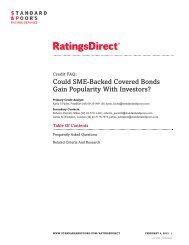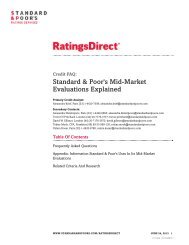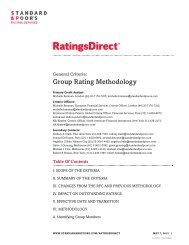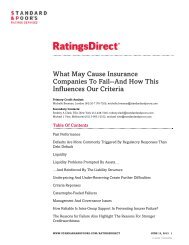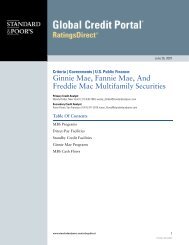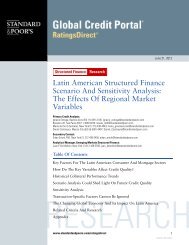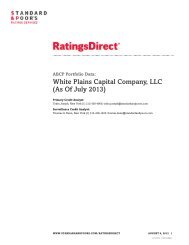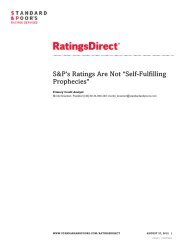Bank Ratings Incorporate Expectations For ... - Standard & Poor's
Bank Ratings Incorporate Expectations For ... - Standard & Poor's
Bank Ratings Incorporate Expectations For ... - Standard & Poor's
You also want an ePaper? Increase the reach of your titles
YUMPU automatically turns print PDFs into web optimized ePapers that Google loves.
Table 3<br />
Historical RAC Ratios Pro <strong>For</strong>ma <strong>For</strong> New Hybrid Criteria And BICRA Scores (cont.)<br />
Note: All figures are pro forma for the new BICRA and hybrid capital criteria published in November 2011. BICRAs, economic risk scores, and sovereign ratings are as of<br />
Nov. 30, 2011. *RBS' ratios exclude the effect of the Asset Protection Scheme. §We computed our estimated RAC ratio as of year-end 2010 by combining public or<br />
confidential information provided on regulatory Pillar 3 data of the sector's key members: Local cooperative banks, DZ <strong>Bank</strong> Group, Deutsche Apotheker- und Aerztebank<br />
eG, and WGZ <strong>Bank</strong>. Cross holdings and interbank placements within the group have been retreated according to our best efforts to compute an estimate for the<br />
consolidated entity. †We computed our estimated RAC ratio as of end-year 2010 by combining public or confidential information provided on regulatory Pillar 3 data of the<br />
group's key members: Savings banks in the States of Hesse and Thuringia and Landesbank Hessen-Thueringen Girozentrale. Cross holdings and interbank placements<br />
within the group have been retreated according to our best efforts to compute an estimate for the consolidated entity. ‡BBVA pro forma RAC ratio at year-end 2010<br />
includes the consolidation of stake in Turkish bank Garanti.<br />
Risk-weighted assets assumptions for U.S. bank holding companies<br />
To help preserve consistency, comparability, and transparency of our published RWA, we've made the following<br />
assumptions, most of which we've based on publicly and consistently available information for the purpose of<br />
assisting reproducibility of this study. The assumptions are nearly identical to the ones we published in "U.S. <strong>Bank</strong>s'<br />
Risk-Adjusted Capital Has Improved, But Remains Neutral To Negative <strong>For</strong> <strong>Ratings</strong>" on Jan. 18, 2011. We also<br />
took into account confidential information, mainly regarding financial collateral and securitization exposures.<br />
• The exposure data mostly derive from the FR Y-9C disclosures, using our criteria (see appendix A of "<strong>Bank</strong><br />
Capital Methodology And Assumptions," published Dec. 6, 2010).<br />
• We also took into account assets under management and assets under custody from the 10-Q reports.<br />
• When adjusting for tax-loss carry forwards in the numerator of the ACE-to-RWA ratio, we used the U.S.<br />
regulators' disallowed portion of the deferred tax assets number disclosed in schedule HC-R.<br />
• We did not make explicit adjustments for guarantees obtained.<br />
• We used the region "world excluding U.S." to represent U.S. banks' foreign-exposure classes identified in the FR<br />
Y-9C. We assumed other exposures were in the U.S. As of September 2010, this translated into a rating of 'A+'<br />
for foreign sovereign exposures, a BICRA of '4' for foreign financial institutions exposures, and an economic risk<br />
score of '3' for foreign corporate exposures. We assumed all retail exposures were domestic. We assign average<br />
GDP-weighted BICRAs, economic risk scores, and long-term foreign-currency sovereign credit ratings to groups<br />
of countries and regions.<br />
• Equity exposures were split between public and private using FR Y-9C schedules HC-B 7d for public equities and<br />
HC-F4 for private equity. We assumed all equity exposures had risk consistent with the equity market group 1 (to<br />
which the U.S. belongs).<br />
• We did not use any explicit adjustment for latent gains.<br />
• We assumed that banks use the internal-model approach (value at risk) to measure all of the general risk in the<br />
trading book and use the standardized approach to measure specific risk.<br />
• We included information of financial collateral that trust banks provided, recognizing a mitigation of the credit<br />
risk, especially for securities-lending portfolios. We applied haircuts (i.e., value reductions) to the financial<br />
collateral according to table 11 (below paragraph 76) of our criteria published on Dec. 6, 2011.<br />
• We based securitization exposures risk weights on detailed breakdowns of exposures per rating, or on our default<br />
values disclosed in paragraph 70.<br />
<strong>Bank</strong> <strong>Ratings</strong> <strong>Incorporate</strong> <strong>Expectations</strong> <strong>For</strong> Improving Capital Assessments Globally<br />
www.standardandpoors.com/ratingsdirect 19<br />
948538 | 300076937




